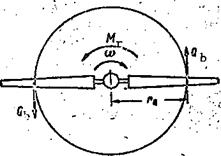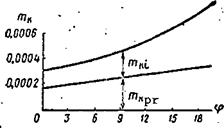Power and Torque Required to Rotate Main Rotor
In order for the main rotor to turn, the action of the reactive torque must be overcome, i. e., driving torque must be supplied to the rotor.
The torque Mt ^ which must be supplied to the main rotor is termed the /22
required torque. In magnitude, it equals the reactive torque — in direction, it opposes the latter
= пі F £ (toR)2 R tor tor 2
where in is the torque coefficient, tor
The torque coefficient is a composite quantity, i. e.,
m = m + m
tor tor tor.
pr і
![]()
![]()
![]()
![]() is the part of the torque coefficient due to profile drag forces. This part depends on the condition of the blade surface, the rotor rpm, and the blade shape; is the part of the torque coefficient due to the induced drag forces and depends primarily on the main rotor pitch (Figure 18).
is the part of the torque coefficient due to profile drag forces. This part depends on the condition of the blade surface, the rotor rpm, and the blade shape; is the part of the torque coefficient due to the induced drag forces and depends primarily on the main rotor pitch (Figure 18).
The formula for the required torque, and also the curve of this torque coefficient versus rotor pitch, makes it possible to conclude that the main rotor required torque will increase with increase of the pitch, rpm, and air density.
We recall that power is work per unit time. The concept of the power required to turn the main rotor can be obtained if we examine the work expended in overcoming the forces resisting the rotation of a single blade, and then the work expended in overcoming the reactive torque of the entire rotor (Figure 19).
The work of a single blade during one revolution of the main rotor is
A,“°b2’V
The main rotor work per second, i. e., the power required, is /23
|
|
|
|
N = A, kn req b s
where к is the number of blades;
n is the rps.
s
Consequently,
N = Q. 2irr_kn req b Q s
since
Q rnk = and 2Ttn. — «),
Q P J
then
![]() N = M o) .
N = M o) .
req p
Both the power required and the torque required for the main rotor
change with change of the pitch, rpm, and air density. In order to turn the
|
rotor, engine power equal to the power required must be supplied to the rotor shaft. This equality is the condition for constant rpm
N = N sup req
where Ng Is the power supplied to the rotor from the engine.
If the power supplied NgUp > rotor rPm will increase. However,
if N < N the rotor rpm will decrease, sup req r













